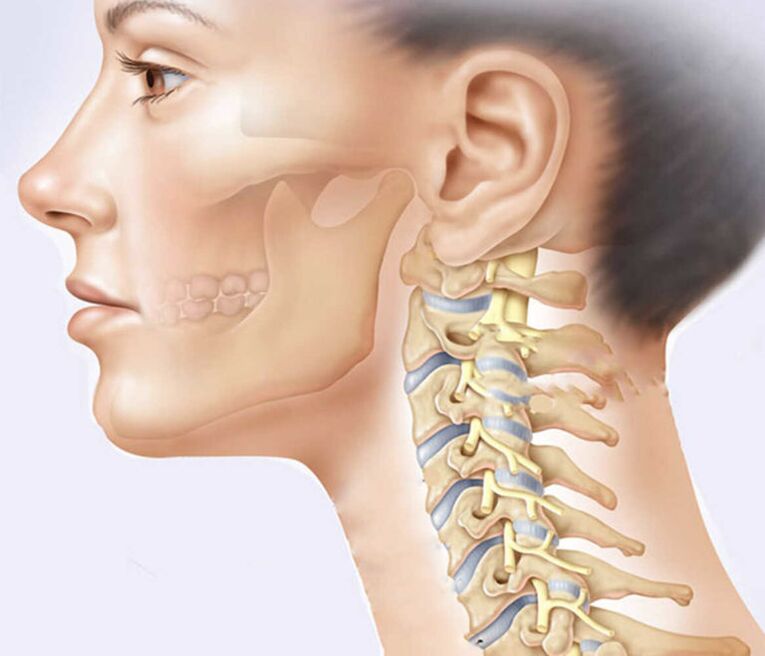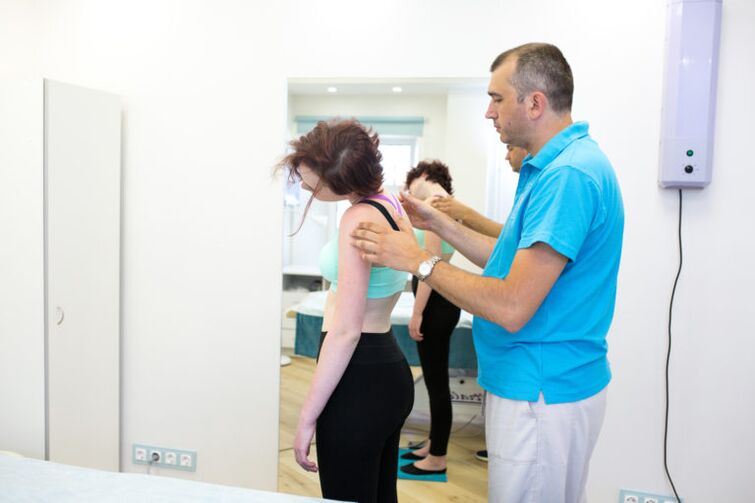Everyone experienced severe pain in the neck. This does not require an accident or abnormality in the structure of the vertebrae. Inadequate workplace organization, sedentary lifestyle, intense physical activity - all this can lead to intense pain. As we age, the manifestations of osteochondrosis can be complex, and diseases of the internal organs only cause problems.
Sharp neck pain can occur suddenly, such as with a sharp twist or tilt of the head. It can radiate to your head (especially the back of your head), chest, or even your shoulders. Such phenomena are often a consequence of cervicago or acute muscle cramps. We were standing in a draft, lifting a heavy one - severe neck pain can last for 5-10 days, but then it goes away. If the duration of pain exceeds 10 days, they are sharp, sore or pulling, they significantly reduce the quality of life - you need to seek treatment.

As many lymphatics, large veins, and arteries pass through the cervical region, the problems within it must be treated carefully. The locomotor cavity of the neck contains the thyroid gland, the pharynx, the beginning of the esophagus, the upper part of the larynx and trachea. The neck muscles are involved in the movement of the head, shoulders and even the jaw. Therefore, if you experience neck pain, see a doctor immediately to find out the causes and prevent many serious problems.
Doctors examine the condition of the spine and brain, take an x-ray, CT or MRI, and check the tension in the muscles of the neck, shoulders and upper back. Determining the cause of the pain may not result in the need to treat the cervical spine at all. You also need to be prepared to make exercise a part of everyday life.
Severe cervical spine pain is a very important and practically significant problem in neurology. Its importance is determined by the following factors:
- neck pain associated with osteochondrosis is the most common pathology caused by non-infection.
- painful sensations in the neck are prone to chronic course with exacerbation. Frequent intense pain can result in temporary or even permanent disability.
These factors determine the importance of accessing timely medical care. If you experience any discomfort or pain, consult a specialist immediately. Self-medication in such cases is unacceptable as it can cause serious complications.
In addition, self-healing often necessitates surgery and causes disability in adults.
Only one physician can develop a competent therapeutic regimen, including pain relief.
Types of neck pain
A distinction should be made between neck pain (cervicalgia) and cervical lumbago (cervicago). Cervicalgia:
- surface somatic - involves damage to the skin;
- deep somatic - due to damage to the neck muscles and vertebrae;
- visceral - scattered, caused by infections or diseases of the internal organs.
Cervical lesions affecting adjacent areas can be divided into two types:
- cervicobrachialgia - cervicobrachial syndrome with pain radiating from the neck to the shoulder;
- cervicocranialgia - pain sensations begin directly in the neck region or occipital region and spread to the head.
All types of cervical lesions can be acute or chronic. The acute phase lasts for about 10 days, but can become chronic without proper treatment. Chronic pain lasts for more than three months.
Cervicago is always an acute pain sensation that localizes in the cervical spine and does not allow you to turn your head.
If the discomfort is caused by neuropathic causes, they can be central (with damage to the spine) or peripheral (damage to the peripheral nerves).
Causes of neck pain
Traditionally, the causes of neck pain can be divided into two groups - due to diseases of the spine or other factors. The former develop in the background of intervertebral hernias, arthrosis, joint dysfunction, and vertebral subluxation (whiplash). The consequences of these injuries can be felt throughout life. The second group includes neck pain caused by infectious and endocrine disorders, tumor processes, rheumatism.
One of the most common causes of neck pain is:
- Myofascial syndrome.Occurs in the background of prolonged excessive tension in the neck muscles, sprains, hypothermia. They usually cause short-term, moderate-intensity painful sensations in which head mobility is often limited and muscles are spasmodic. When pressed, pain and induration are felt. Often, the pain caused by myofascial syndrome disappears on its own within 4-5 days.
- Osteochondrosis of the cervical spine.The disease is a degenerative-dystrophic lesion of the spine that results from deformation and destruction of the intervertebral discs. Loss, compression, and destruction of the elasticity of the plates result in overload of the facet joints, arthrosis, and constriction of the nerve roots. This leads to the whole neck hurting a lot. As we age, a decrease in cartilage hydrophilicity leads to a decrease in intervertebral distance and damage to intervertebral joints.
- Dysfunction of facet joints.Damage to the structure of the intervertebral joints is one of the most common causes of pain throughout the neck. Cartilage thins on joint surfaces. This causes the appearance of bone growths - osteophytes. They narrow the lumen of the holes between the vertebrae, causing the nerve endings to compress. As a general rule, this is accompanied by a dull (gradually increasing, low-intensity) pain in the neck region, which intensifies in the morning after sleeping in an awkward position - lying on a high pillow, on your stomach. During movement, the pain may increase, but it will weaken at rest. In this case, pain radiating to the back of the head, ears, temples, shoulders is possible.
- Herniated and protruding discs.Compression of intervertebral discs, which have lost their elasticity, causes protrusions - protrusions into the spinal canal with the subsequent formation of a hernia. This leads to compression of the spinal cord, which interferes with the sensitivity of the hands - accompanied by numbness, burning sensation, weakness, pain. The shot (irregular one-sided) is increased when bending, rotating the head, or throwing back. Therefore, one should instinctively tilt one’s head forward and to the opposite side of the localization of pain.
- Cervical myelopathy. . . Prolonged compression of the hernia interferes with blood circulation in the spinal cord. Because of this, not only does the whole neck hurt a lot. But the violation is accompanied by pain that radiates to the area between the shoulder blades and to the shoulder. They get worse on the move and don’t go away after you take painkillers. Characteristic signs of neck pain with cervical myelopathy are goosebumps, numbness of the arms and legs, and subtle motor disorders. Sometimes dizziness is possible, memory deteriorates, gait changes.
- Whiplash injuries.They are formed as a result of a sharp backward or forward bending of the neck, followed by a retraction in the opposite direction. Such injuries often occur in an accident, but can even be provoked by an ordinary relapse. Trauma is the result of stretching and damage to the muscles, ligaments of the intervertebral discs, and cervical vertebrae. The most severe cases are accompanied by dislocations and fractures. The injury can result in the whole neck and shoulders hurt a lot, migraines occur, the muscles are cramped. Concomitant symptoms include blurred vision, increased fatigue, and frequent attacks of headaches.
In addition, neck pain can be caused by muscle tone syndrome. It is a condition that causes prolonged cramps in several muscle groups in the head, chest, and neck. Compression of neuromuscular triggers leads to pulling, sometimes very intense pain. In particular, squalene muscle syndrome is a syndrome accompanied by a violation of the innervation and circulation of the neck scalene muscles that go from the cervical vertebrae to the 1st and 2nd ribs. This syndrome is characterized by neck pain and stiffness, which most commonly occur in the morning. In such cases, the head usually leans forward and slightly toward the tense muscle. Painful feelings can be mild, painful, but sometimes sharp, intensifying at night, taking a deep breath while tilting your head to the healthy side. Sometimes pain can be radiated to the shoulders, axillary and interscapular regions, and the front chest.

However, the causes of pain are not just diseases of the spine. First, infectious pathologies, especially nonspecific or tuberculous spondylitis, epidural abscesses must be ruled out. Metastatic changes in the vertebrae can also be associated with persistent pain that does not subside, but rather worsens at rest. They are characterized by rising body temperature, general weakness, and sweating. Even slight pressure on vertebrate processes causes local pain.
Risk factors for pain include flat feet, posture curvature, and strenuous exercise. Cervicalgia can occur in the background of constant overload, vibration, prolonged immobility of the body (for example, with fractures).
In addition, pain can occur due to wearing tight and uncomfortable clothing, malnutrition, and diseases of the internal organs. Taking these factors into account, we obtain a wide variety of clinical cases of the development of cervicalgia.
Your neck hurts: who to contact and what to do
If your neck hurts, traditional medicine offers drug treatment with drugs with different spectra. They are used to overcome pain, alleviate infectious or inflammatory processes, and eliminate unpleasant symptoms. Surgery is performed only in very severe cases.
Medication is based on the administration of local anesthetics, painkillers (NSAIDs), hormonal drugs (glucocorticoids), muscle relaxants (drugs to relieve muscle tension), antioxidants, and, if necessary, antidepressants and antispasmodics. Treatment is based on painkillers - medicines from other groups are prescribed at the same time, which increase the effect of the painkiller, relieve inflammation and swelling.

The disadvantage of drug treatment is that it has plenty of side effects and temporarily relieves pain. Moreover, such treatment is only aimed at eliminating the symptoms, but by no means at the root cause of the pain.
Who should be entrusted with such an important class of the body - the neck? Severe pain does not require a specialist, but a whole team that carefully examines, sets up the correct diagnosis, and prescribes therapy.
They use an integrated approach based on a combination of the following non-pharmaceutical methods:
- Physiotherapy.The neck muscles are very difficult to train, so when choosing exercises, experts focus on the mobility of the chest region, the shoulder girdle, and the even distribution of the load on the spine. Physician doctors select the optimal set of exercises aimed at shaping the posture and eliminating neck pain.
- Kinesiotherapy.Clinics use kinesiotherapy systems. The installation allows for deep training of the muscles of the cervical spine. Closed-circuit exercises can be used to effectively treat skeletal neuromuscular problems and increase class functionality.
- Osteopathy.Osteopathic neck correction is safe and painless, suitable for adults and children, pregnant women and professional athletes. Unlike other therapeutic methods, osteopathic medicine not only eliminates pain syndrome, but also frees the patient from the source of the pain, treating the underlying disease. To do this, tactile and manual manipulation techniques are used on the muscles, joints, nerves, connective tissue, neck veins and capillaries. Osteopathic drug methods accelerate healing, increase the effectiveness of therapeutic, prophylactic, or rehabilitative measures.
- Manual therapy.Effectively relieves neck tension. Specialists gently influence the biologically active points, eliminate subluxations, perform displacements and manipulations aimed at relaxing the neck muscles and stretching the spine.
The right combination of competent selection and therapeutic methods will help eliminate neck pain and get rid of discomfort. The integrated approach involves the joint, well-coordinated work of different professionals - rehabilitologists, neurologists, traumatologists, orthopedists, psychologists. They all follow the common goal of relieving the patient’s pain. An individual approach to everyone, a combination of osteopathic and physiotherapy procedures is important, and they work even for the deep, spiritual reasons that the whole neck hurts a lot.

















































